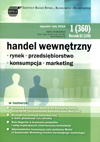Assessment of Food Safety by Lithuanian Consumers
Assessment of Food Safety by Lithuanian Consumers
Author(s): Maria Jeznach, Jurgita Kulaitiene, Elvyra Jarienė, Honorata DanilcenkoSubject(s): Economy, Education, Health and medicine and law
Published by: Instytut Badań Rynku, Konsumpcji i Koniunktur
Keywords: food safety; Lithuanian consumers;
Summary/Abstract: Introduction: In Lithuania, there is an insufficient attention to public education and to creating attitudes towards the quality of the consumed food. The aim: To find out how Lithuanian consumers assess food safety. Materials and methods: 466 respondents took part in the research. The questionnaires had been distributed at shopping centres. The results of questionnaires were processed by the SPSS. Respondents were split into the following age groups: 18-30; 31-40; 41-50; 51- 60 and 61 years and older. Results of the survey were grouped by age. Results: The majority of respondents answered that “organic food is not necessary safe”. Most of the participants in 18-50 age groups claim that the letter E marks preservatives, but older than 51 stated that the letter E marked the food products approved by the EU. The press, Internet and the radio were more often mentioned as the source of information about healthy food and food additives by the participants of the age group of 41 years and older. The groups younger than 51 years old specified that the information received on food and additives was not sufficient. The majority of respondents thought that the main food safety risks were microorganisms, pesticides, and chemicals, BSE, while the 61 and older – that GMO, acrylamide, and irradiation. Conclusions: The research demonstrates that consumers are insufficiently informed on proper nutrition, safe food products, different food additives and pollutants that may pose a potential risk to public health. The present survey has the potential to form an opinion of how Lithuanian consumers assess the food safety. This study is low-budget and easy to analyse; moreover, we believe that it could be modified appropriately to fit the assessments and habits of other populations, too.
Journal: Handel Wewnętrzny
- Issue Year: 2013
- Issue No: 4
- Page Range: 28-37
- Page Count: 10
- Language: English

